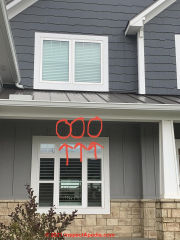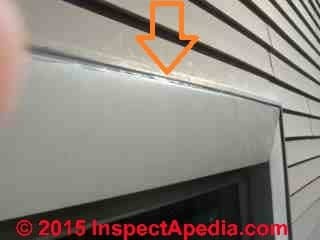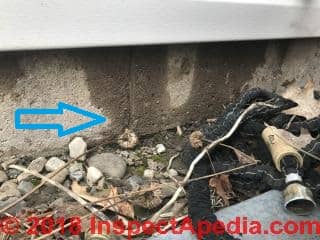 Siding Leak Repair FAQs
Siding Leak Repair FAQs
Q&A on how to diagnose, repair or prevent leaky siding
- POST a QUESTION or COMMENT about leaks in building walls or siding
Siding leak diagnosis and repair:
Siding isn't waterproof; but how do we find the source of leaks in aluminum siding, vinyl siding or other building siding systems? How can we prevent or repair leaky building siding?
This article describes the causes of all types of leaks in building siding and wall coverings. Using detailed examples and photos of leaky building siding, siding stains, ice, or other leak clues for vinyl siding we illustrate the installation mistakes or subsequent siding damage that can cause troublesome, even dangerous leaks into a building wall or wall structure.
The article includes a catalog of all sorts of causes of leaks into building walls and provides links to in-depth diagnostic and repair articles for each of them.
Our page top photo, courtesy of an InspectApedia reader, shows water leaking out of building siding and showing up as a wet spot on the concrete block foundation wall. The nearby garden hose (photo lower right) could be a clue telling us to look for a plumbing leak in the building wall in addition to other more-common causes of water leaks behind building siding.
InspectAPedia tolerates no conflicts of interest. We have no relationship with advertisers, products, or services discussed at this website.
- Daniel Friedman, Publisher/Editor/Author - See WHO ARE WE?
Leaky Vinyl or Aluminum Siding: cause, effects, cure
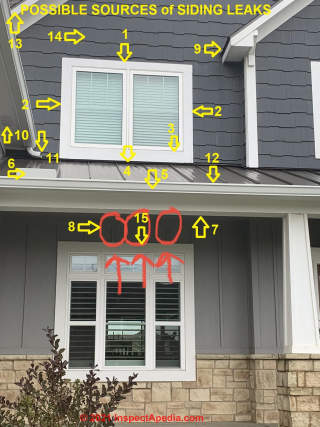 These questions and answers about finding and fixing leaks in vinyl or aluminum siding were posted originally
These questions and answers about finding and fixing leaks in vinyl or aluminum siding were posted originally
at SIDING LEAK DIAGNOSIS & REPAIR - topic home, so be sure to review that article.
[Click to enlarge any image]
On 2021-11-12 by Inspectapedia Com Moderator (mod) - possible leak points that send water into building at window top
@Ashley,
With just a photo and brief text we can not know for sure just why you're seeing water leaks at the window and siding in your photo, but your statement
"... water was dripping from the top of this window the inside the house and on the outside of the window."
sure suggests improper window or flashing installation above the window and perhaps other construction snafus like improper housewrap or missing or improper flashing details nearby and above the point of leakage.
If investigation finds that to be the case, I'd be worried that the same worker made the same errors elsewhere when the home was built. Not every mistake results in a leak: the combination of mistake plus specific location and building design and shape and other site factors will mean that some mistakes get off scot-free while others cause leaks, wet insulation, hidden wall or ceiling cavity mold contamination, and over time, invite rot or insect damage.
It would be helpful to know how the observance of leaks at the lower window relate to weather conditions: during rain, snow, snow melt, humid conditions, wind, temperature, etc.
In your photo I can name at least the following potential points of water leaks into the wall that might send water down behind siding and in over an improperly-installed window:
1. Improper or missing window top flashing, sealing or improper placement of housewrap at the window top (behind rather than over flashing
2. Improper window side flashing
3. Leaks at the bottom of a window where weep openings are improperly located or closed-off or leaks in the window itself that leak into the jamb and wall
4. Improper or missing flashing at the abutment of lower roof to upper building wall below the window
5. Improper gutter installation (atop drip edge, inadequate slope, clogging) can cause gutter fill-up, back-flow down fascia, into soffit and towards building walls.
6. Volume of water from downspout exacerbating the conditions at #5 above
7. Condensation or leaks into soffit that slopes towards house wall enough to send water into an improperly-flashed wall top
8. Missing or improper flashing behind top of siding at wall top or improper housewrap placement in that location
9. Improper sept flashing on upper roof permitting leaks into the building wall, behind siding
10. Inadequate roof, attic, soffit intake venting (and perhaps inadequate exit venting) inviting condensation in roof cavities and attic; at eaves that condensate can also leak down into walls.
11. Downspout spilling onto roof near building wall/roof juncture risks overwhelming roof-wall flashing or seal at abutment of lower roof to wall
12. Missing or improper drip edge or gutter atop drip edge can send water down fascia and into soffit rather than into gutter
13. Leaks in roof can send water down building wall cavities or behind siding
14. Leaks in siding or improper housewrap installation behind siding, no working drainage plane can send water into the wall cavity
15. Improper or missing flashing at the lower window top allows water that has leaked behind the siding to enter the window structure, building wall, at the window top ,
While it's not at all likely that all of these mistakes are present, a careful onsite inspection and water testing, combined with moisture measurement can help track the water source back up the structure from where water has been found leaking into the window and out of the siding.
Where siding is metal a moisture meter won't work well but in wet conditions thermal scanning can help follow the water path.
Be sure to read the parent article
SIDING LEAK DIAGNOSIS & REPAIR for which you're on its FAQs page.
Watch out: where there have been leaks into the building wall cavity there is risk of hidden mold, insect or rot damage as well as wet insulation.
On 2021-11-12 by Ashley
We have had rain water dripping down in front of windows under our porch roof where rain doesn’t hit. It appears the vertical pieces of lap siding are serving as a conduit for water.
We’ve had people come out to look at the metal roof above the window, we’ve had a water test done and that didn’t yield results. It seems to happen with wind blown rain. Any thoughts are appreciated. I am inclined to have the vertical lap siding pieces removed, if possible, and go from there. I have attached images for clarity.
One picture is of the widow down which water has been dripping and has the three vertical pieces on the siding circled where water is dripping down.
We don’t know if this is a porch roof issue, an upper level window issue or something else. There is no evidence of water on the inside of the house, however the first time this happened when we were home last year, water was dripping from the top of this window the inside the house and on the outside of the window.
On 2018-10-27 by (mod) - a water hose could be a way to search for leaks?
Applied with some sense, yes.
Never squirt water UP under siding nor at high pressure or you may blow water into the buiding wall cavities.
On 2018-10-27 by Anonymous
Thank you. So, then would you agree that a water hose could be a way to search for leaks?
Jo
You point out an opportune time to check for remaining leaks either at the roof eaves or in the walls above or at your kitchen, since the walls remain open.
1. Look into the wall cavities for water stains - signs of water leakage.
2. Follow the stains to their highest point.
3. Examine the walls (or roof eaves or soffits) immediately above that point for leaks or openings that have not yet been repaired.
On 2018-10-27 by Jo
I have had water intrusion in my kitchen after heavy rains. Rotten wood siding has been replaced and foundation sealing has been done. My kitchen has been gutted and before I install a new kitchen, how can I make sure the repairs solved the water intrusion problem.
For three months now we have had little rain. Would a water hose soaking on the new siding be a way to check?
(I have been unable to hire a general contractor because no one is interested or too busy with big jobs.) Incidentally, this is a two story townhome with stucco on the bottom and wood siding on the second floor level. Thank you for any insight/help you can give me.
On 2018-09-20 5 by (mod) - how maddening it can be tracking down a wall or siding leak
Brenda
I appreciate how maddening it can be tracking down a leak; it's not enough to know that water runs "down" because it can also travel horizontally, such as along a butt joint between two sheets of plywood or in the J-channel over a window or in the siding bottom edge (of vinyl or alumium.)
But it does help to know water doesn't go uphill. So the leak, wherever it is, is most likely above where it first appears.
In your case the leak could also be in a roof, at a roof vent, ridge vent, eaves vent, plumbing vent, damaged shingle, even a backing-up gutter sending water into a sofffit, or an attic air conditioner leaking condensate into the ceiling below.
Considering that the ceiling has been ruined, and that wet drywall means a gold plated invitation to mold growth, you need to tear out the ruined drywall and any insulation that got wet.
Inspect in the attic or a water source that may be finding its way down to the lower floor ceiling.
Inspect outside for the most obvious snafus that can be detected by mere visual inspection: improperly-cut J-channel over windows or doors, penetrations at outdoor fixtures, damaged siding, etc.
Consider, if the leak is ongoing, a thermography scan - wet areas will show up as different (lower) temperature. That can be indicative. OF course if the leaks have dried, skip the IR or thermographic scans.
Then tear out the ceiling and follow the water stains back to either a point from above in the attic and interior wall partitions or in the building exterior wall.
On 2018-09-20 1 by Brenda Fay
We have a leak somewhere between the 1st floor and 2nd story on the back of the house north side ceiling has been ruined in the first floor room no sign of water upstairs have sprayed the siding trying to locate it to no avail we are at the point of removing the vinyl siding any suggestions oh we get water running in with rain coming from the north
On 2018-04-30 2 by (mod) - one siding guy and didn't trust him, was pushy and didn't ask me enough questions
Assuming this is new, incomplete construction,
I would
1. find a contractor to fix the gutter asap
2. Follow the water up inside to guess that the point of entry from outside is above that spot. I suspect a combination of water running down the exterior wall, getting behind siding, and housewrap installation errors that let water leak through the wall sheathing.
based on that you can decide if you need to remove moldy drywall or if you can dry and paint.
I would also look with care in the attic and into the soffits to be sure roof runoff isn't entering the wall cavity from the very top of the wall.
On 2018-04-30 by Michelle
I Just found out that water is leaking into my house, it's where a gutter was not replaced by roofers.
There is a board that doesn't seem to be siding and this seems to be where it's comeing in. The other side of this wall has not been sheetrocked in yet so I can look at it.
Most of it looks fine but is wet, the bottom might have mold. What I need to know is if I can dry it out and seal it all and fix the leak myself or do I need to have a professional come out?
I talked to one siding guy and didn't trust him, was pushy and didn't ask me enough questions and I have had shoddy work done in the past and don't know how to find someone I trust. I also don't want all the siding removed from the whole back side of my house if I don't have to. Please just tell me what to do. Thank you!
On 2018-02-03 by (mod) - hemmed flashing & steps find where the water intrusion is coming-from
PS
You do need some detective work to find where the water intrusion is coming-from: missing chimney cap, missing chimney flashing, other wall or window flashing omissions, etc.
In the UK these flashings are typically called soakers or lead soakers. In the UK the lead flashing segments or soakers are wedged in place in the chimney reglet with a metal or lead wedge. Where I've done this I sealed the bent-edge into the chimney reglet cut using a high grade silicone sealant.
The illustration below is from a discussion of use of soakers along the vertical side of a chimney - I'm looking for the original source. 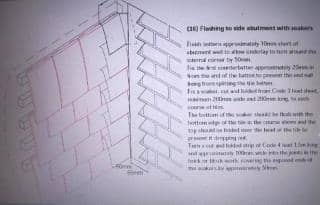
Step flashing is used along the intersection of a vertical wall to a sloped surface, such as where a chimney penetrates a sloping roof.
In a common vertical chimney side flashing approach metal (sometimes lead, else copper) vertical flashing would be installed let into a reglet cut into the side of the brick chimney and sealed there, then bent over the exterior of the J-flashing (that will receive the ends of the siding) and sealed to it.
Alternatively metal (sometimes lead, else copper) vertical flashing would be installed let into a reglet cut into the side of the brick chimney and sealed there, then bent over the wall siding and taped with flashing tape to the housewrap before the siding J-channel is installed snug against the vertical chimney side.
The danger of this approach is dealt with by my next comment.
For siding other than vinyl or aluminum there is no J-flashing. Instead the wall side of your 90 degree bent flashing is placed against the house sheathing and under the siding.
To avoid accumulating so much water under the siding that it leaks horizontally to find an entry point, some contractors use short pieces of metal flashing that brings water out to the *outside* of each third course of siding (such as wood shingles or wood clapboards). I have not seen builders bothering to use one step of flashing for every shingle course though in a very wet high wind ocean front location that might make sense.
A hemmed edge doubled over at the vertical edge of the innermost side of the flashing against the house sheathing (behind the siding) can also prevent wind-blown water from leaking past the flashing edge into the rest of the wall.
Be sure that the bottom edge of each vertical flashing segment is brought out on top of the head of the shingle or siding course below. The flashing can still be hidden by the succeeding course as long as its overlap on the siding course below is slightly less than the head lap of the shingle or siding courses.
I do NOT rely on even high grade sealants such as Geocel in this location. I just don't trust that thermal movement of siding and flashing wont' rip a hole in the sealant during the building's life.
See also FLASHING SIDING DETAILS
Also take a look at FLASHING, CHIMNEY MISTAKES & LEAKS 
On 2018-02-03 00:33:12.437911 by Ashley
What is the best way to install vertical Vinyl siding adjacent to a brick chimney, to prevent leaks? It is a water front location with high winds.
I have seen some comments about step flashing that is installed at the time of the brickwork.
This was not done. We are waiting to install wood floors, but keep seeing subfloor moisture levels spike with rain events. Plan to do some moisture intrusion testing in the crawlspace to see if a leak is suspected.
On 2017-11-24 20:12:55.199043 by (mod) -
Anita,
Thank you for asking - as it lets me clarify something important: we do not list "Wayne Wiles" nor discuss Wayne Wiles anywhere in any article at InspectApedia.com
My GUESS is that Google's AdSense program placed an advertisement from Wayne Wiles Carpet Tiles on web pages that you were viewing, based on Google's guess at what is interesting to you.
InspectAPedia is an independent publisher of building, environmental, and forensic inspection, diagnosis, and repair information provided free to the public - we have no business nor financial connection with any manufacturer or service provider discussed at our website. We do not sell products nor services.
On 2017-11-24 16:55:47.764504 by Anita
Why underneath all siding information do you list Wayne Wiles, & he's acarpet tile person!
On 2017-08-10 11:35:56.612127 by Richard N.
Question; vinyl siding was newly installed on one wall that had water damage from older siding. The "new" siding crew was called back to repair an inverted corner that allowed water to gush in between Sheetrock and external plywood. Now, the window that was also wrapped and had new siding is leaking . The contractor tells me it's the window and not the siding, mind you this is from a man who had to personally watch his crew the second time, repair the corner. My question is.,could the siding install be bad at the window (as was the corner) or is it the window?!! Also note that I've removed the Sheetrock and bad plywood on the interior walls and can see water draining down the brick which would otherwise be covered. Would I be justified in demanding that the siding be removed and window flashing/caulking inspected before payment is made?
On 2016-08-04 18:58:40.362695 by (mod) -
Brandon,
With the apology that I can't see your windows to know if the installation details including flashing and sealing are exactly correct, I wanted to explain that we often leave an exit opening at the bottom of vertical or window-side flashing to be sure that water can escape from the area. However escaping water must be brought out on top of the exterior siding or wall covering, not inside it.
Unless you find dampness or stains below the window (inspecting from inside and if justified by inspecting through a small test cut through the drywall inside below the window), I'd be surprised if an opening at the very bottom of the window flashing would explain high condensation inside.
I'd be looking for leaky storm windows, leaky main window sash (air leaks could cause this condensation problem), or a source of high indoor moisture.
See detailed diagnosis and repair suggestions found by searching InspectApedia.com for CONDENSATION on WINDOWS, SKYLIGHTS
https://inspectapedia.com/BestPractices/Window_Condensation_Problems.php
On 2016-08-02 by Brandon
Hello - your site has extremely useful information. Thank you! I have a question, please. We have a two year old house now with vinyl Andersen Windows and spray insulation. The house is very sealed and efficient, however, I've been really struggling with some sort of water or condensation on the interior window sills.
After looking at your site, I noticed on the exterior-bottom-corners of our windows, the j channel is not wrapped around the corners. Therefore, there are some crack openings. The top corners of the windows are wrapped as you suggest. However, bottom corners are not. Do you think I should caulk the bottom exposed corners? Should they be covered from openings - possibly contributing to my interior window sill water issue? Really appreciate any help, thank you.
On 2015-06-28 by (mod) -
Good question, Michelle
I would NOT caulk the area you describe as doing so will possibly make matters worse by preventing water that's behind the siding from exiting at the siding bottom. Siding is not waterproof. Windblown rain can enter the siding. That's why properly-installed housewrap or an equivalent water barrier is required behind the siding. At the siding bottom we want flashing that directs any water running down the wall between the siding back and the housewrap face out onto the lip of the (hopefully sloped) brick lip.
Pull off the bottom siding course, install an L-flashing up under the housewrap and out on top of the brick lip, then reinstall the bottom siding course.
Also check the head flashing at windows and doors as that's often a particularly egregious source of water entry behind siding.
If you find no housewrap behind the siding then the whole job is defective and is going to be a leaky nightmare. Sorry.
On 2015-06-28 by Michelle M
The upper portion of my home is vinyl siding and the lower portion is brick with a brick lip between the two. Water is getting behind the brick somehow and I believe the siding is not sealed properly where it meets the brick lip. I have tried to get a masonry here to look and give me an estimate on fixing as the brick needs some repointing. This is not a big paying job and they are busy and not so interested in getting back to me.
I would like to put caulking between where the vinyl siding meets the brick lip but I am unsure as to whether I should do this above or below the flat piece that is between the two. Any suggestions? I could send pics if that would help.
...
Continue reading at SIDING LEAK DIAGNOSIS & REPAIR or select a topic from the closely-related articles below, or see the complete ARTICLE INDEX.
Or see these
Articles on Sources of Building Exterior Leaks
- GUTTERS & DOWNSPOUTS - leaks can send so much water down a wall that the wall is damaged and leaks
- FLASHING on BUILDINGS - home
- HOUSEWRAP INSTALLATION - improperly-installed, invites leaks into the structure
- ROOF ICE DAM LEAKS - can send water into building siding systems or into the wall cavity
- SIDING, FIBER CEMENT GAPS - installation or shrinkage gaps can leak into the wall leaks
- SIDING LEAK DIAGNOSIS & REPAIR
- SIDING LEAK POINTS & CAUSES
- SIDING WOOD, FLASHING DETAILS
- OVERLAP SPECIFICATIONS for HORIZONTAL VINYL SIDING JOINTS- gaps mean leaks
- VINYL SIDING BUCKLED WARPED
- VINYL SIDING GAPS, HOLES, CRACKS
- WATER ENTRY in BUILDINGS - complete catalog of sources of building leaks & water entry
- SIDING WOOD, FLASHING DETAILS
Suggested citation for this web page
SIDING LEAK DIAGNOSIS & REPAIR FAQs at InspectApedia.com - online encyclopedia of building & environmental inspection, testing, diagnosis, repair, & problem prevention advice.
Or see this
INDEX to RELATED ARTICLES: ARTICLE INDEX to BUILDING SIDING
Or use the SEARCH BOX found below to Ask a Question or Search InspectApedia
Ask a Question or Search InspectApedia
Try the search box just below, or if you prefer, post a question or comment in the Comments box below and we will respond promptly.
Search the InspectApedia website
Note: appearance of your Comment below may be delayed: if your comment contains an image, photograph, web link, or text that looks to the software as if it might be a web link, your posting will appear after it has been approved by a moderator. Apologies for the delay.
Only one image can be added per comment but you can post as many comments, and therefore images, as you like.
You will not receive a notification when a response to your question has been posted.
Please bookmark this page to make it easy for you to check back for our response.
IF above you see "Comment Form is loading comments..." then COMMENT BOX - countable.ca / bawkbox.com IS NOT WORKING.
In any case you are welcome to send an email directly to us at InspectApedia.com at editor@inspectApedia.com
We'll reply to you directly. Please help us help you by noting, in your email, the URL of the InspectApedia page where you wanted to comment.
Citations & References
In addition to any citations in the article above, a full list is available on request.
- In addition to citations & references found in this article, see the research citations given at the end of the related articles found at our suggested
CONTINUE READING or RECOMMENDED ARTICLES.
- Carson, Dunlop & Associates Ltd., 120 Carlton Street Suite 407, Toronto ON M5A 4K2. Tel: (416) 964-9415 1-800-268-7070 Email: info@carsondunlop.com. Alan Carson is a past president of ASHI, the American Society of Home Inspectors.
Thanks to Alan Carson and Bob Dunlop, for permission for InspectAPedia to use text excerpts from The HOME REFERENCE BOOK - the Encyclopedia of Homes and to use illustrations from The ILLUSTRATED HOME .
Carson Dunlop Associates provides extensive home inspection education and report writing material. In gratitude we provide links to tsome Carson Dunlop Associates products and services.


